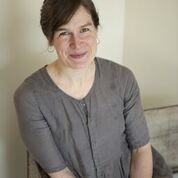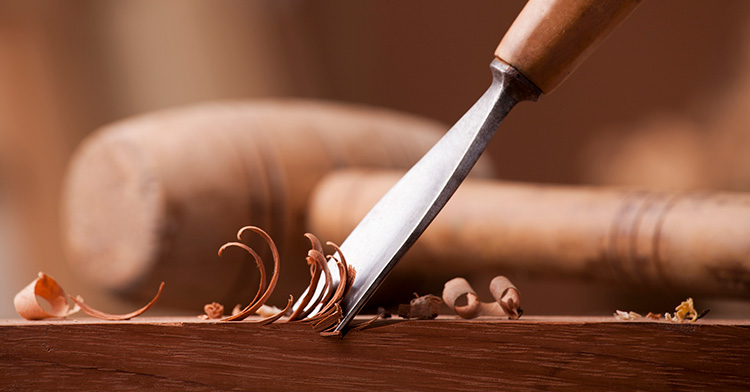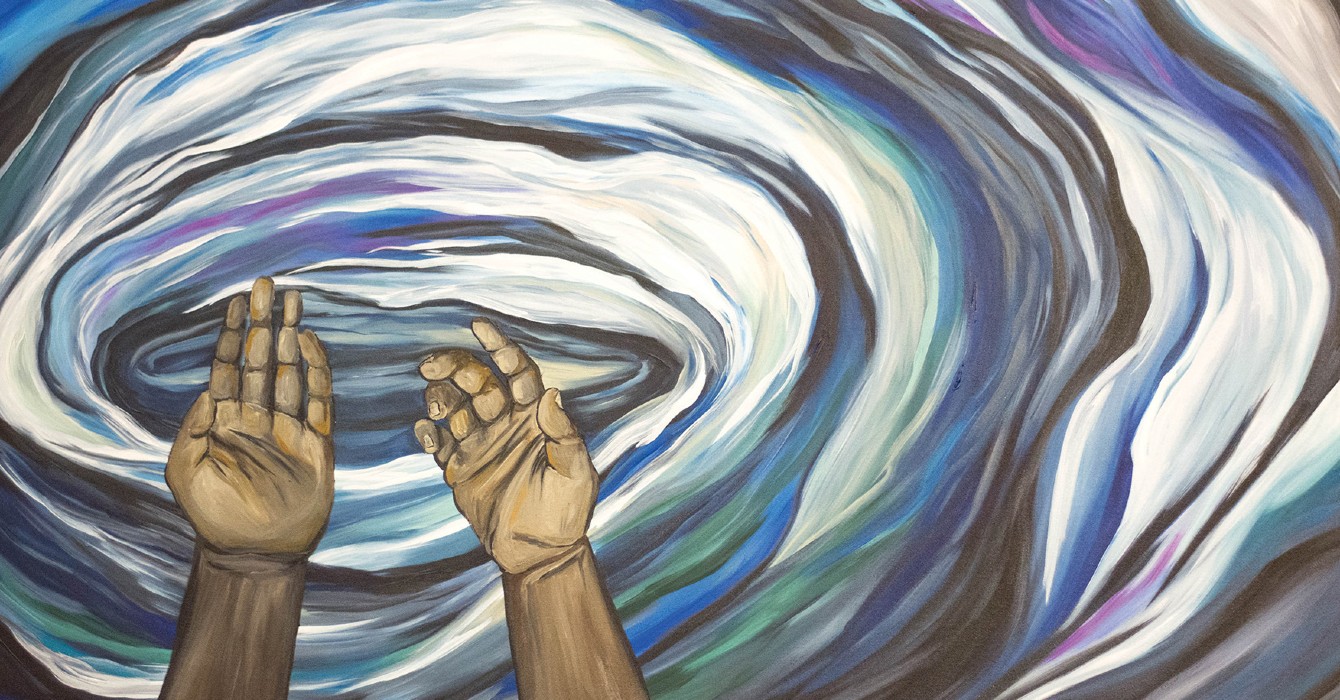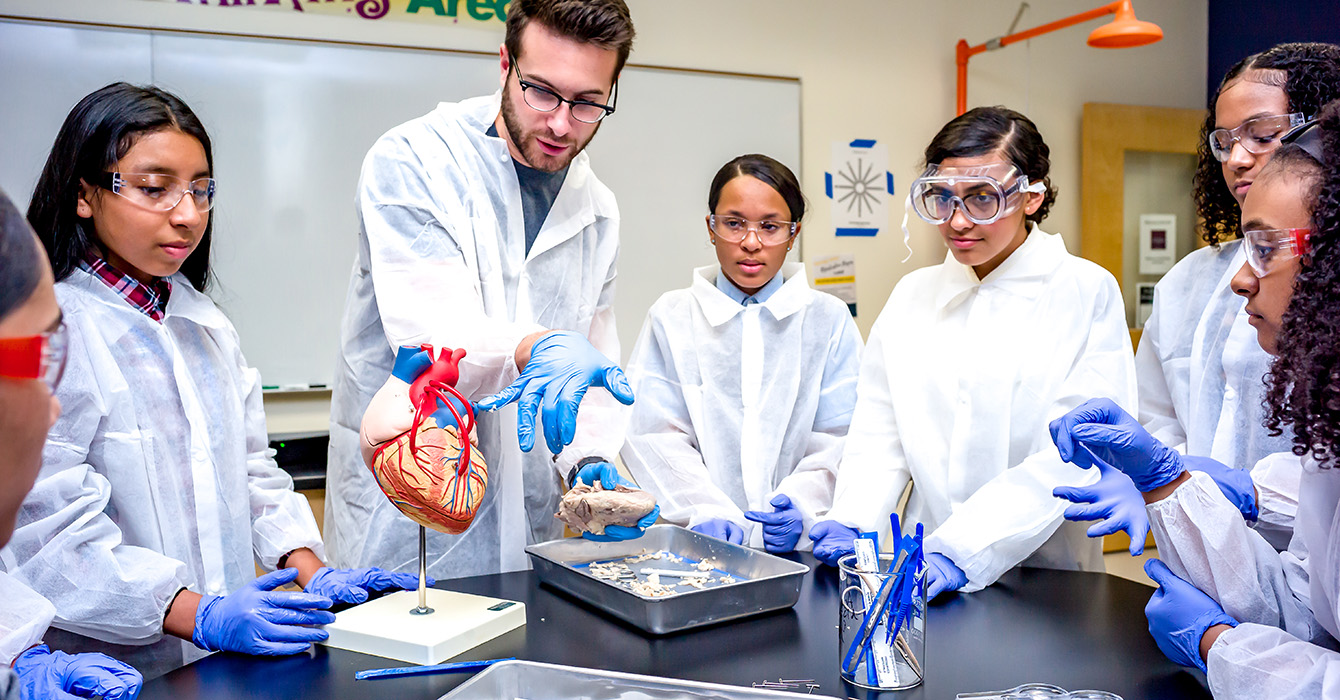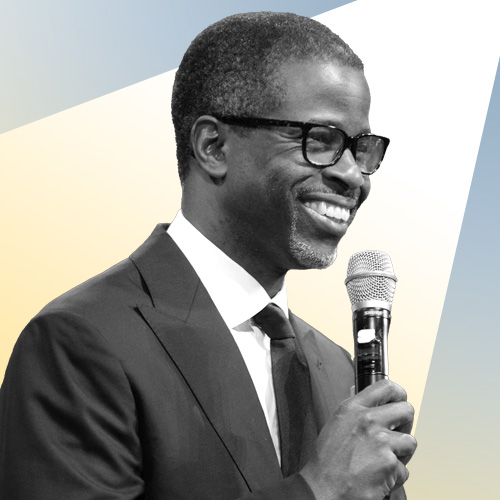In 2009, the Rev. Paul-Gordon Chandler began using the arts to build bridges between Christians and Muslims in Cairo, Egypt, where he was the rector of the historic international Episcopal Church, St. John’s Church-Maadi. The initiative was called “CARAVAN” and emphasized the idea of Abrahamic faiths journeying together through the arts.
The idea grew into a movement, and CARAVAN became a U.S. nonprofit that now hosts interfaith peace-building art exhibitions and initiatives around the world.
Chandler views the arts as a way to build on what the monotheistic faith traditions have in common. Rather than promoting interfaith dialogue, Chandler hopes to inspire interfaith friendships. Chandler was recently interviewed by Dustin Benac, a Th.D. student at Duke Divinity School. The following is an edited transcript.
Q: You describe your work as “peacebuilding through the arts between the creeds and cultures of the East and West.” What shaped your vision for peace building and your interest in the arts?
 I grew up in Senegal, West Africa, a Muslim country -- I grew up as a minority within an Islamic context. I spent my first 19 years there. My father was the minister of the international church in the capital city of Dakar.
I grew up in Senegal, West Africa, a Muslim country -- I grew up as a minority within an Islamic context. I spent my first 19 years there. My father was the minister of the international church in the capital city of Dakar.
The majority of my friends were Muslim, Senegalese or part of the Lebanese diaspora that is in West Africa. Growing up, especially when I was in my late high school years, I began to observe among adults the tensions that existed between Christianity and Islam. I remember thinking, “There is something wrong with this; there has to be another way.”
My relationships were so close with my Muslim brothers and sisters that even to this day they are the only people I know who, without even thinking twice, would step in front of a car for me. That’s how tight the relationships are.
In regard to the arts, Senegal is the artistic capital of West Africa. It’s known widely for its music. Mbalax, for example, comes out of the West African musical tradition, and Senegal is the heart of it. A number of internationally renowned musicians came out of our neighborhood, such as Youssou N’Dour. And, of course, the Senegalese are known the world over for their visual art. They are a very flamboyant people with a bent for the creative.
However, it wasn’t until many years later, when I was living in Egypt and we were focusing on dialogue with our Muslim brothers and sisters, that we decided to use the arts. And it was there that these two passions of mine came together.
Q: How did those experiences lead to your current interfaith work with CARAVAN?
We started with some citywide interfaith art exhibitions, concerts, film screenings, literary events and other programs in Cairo, and we quickly began to observe that art, because it is an indirect way of addressing a subject, allowed new relationships to develop. In 2009, we started something called the CARAVAN Festival of the Arts. We chose a theme, and that initial theme was “Journeying Together,” with the idea of learning from each other on life’s journey.
That first festival met with great success, more than we ever imagined. It began to demonstrate how potentially strategic this peace-building focus through the arts could be. Each year after that, we had a CARAVAN interfaith East-West arts festival.
Q: And the CARAVAN nonprofit emerged out of that?
CARAVAN emerged out of what became a movement, as it spawned other interfaith art initiatives in places around the world with majority-Muslim contexts. However, it didn’t actually become a U.S. nonprofit until just under two years ago, after I left Egypt in the autumn of 2013. The mission is to use the arts to build bridges between the creeds of the East and the West. And not just visual art but all mediums of art. Yet we are heavily focused on the visual arts.
Q: Can you share more about your current traveling exhibition, “The Bridge”?
“The Bridge” is a touring exhibition that opened in February 2015 in Paris, [shortly] after the Charlie Hebdo tragedy. It features 47 Arab, Persian and Jewish artists from Muslim, Christian and Jewish faith traditions. The focus is on building bridges through what we have in common.
After being showcased in Paris, it moved to Cairo, Egypt, then on to London, England, and then to Metz, France. Unlike our usual annual CARAVAN Exhibition of the Art, this one actually overlaps two years, because it is going to about 12 locations. It has just premiered in the United States at St. Paul’s Chapel at Ground Zero in New York City.
It goes on to Chicago, Illinois; Spokane, Washington; and Portland, Oregon; and ends in Wyoming. The reason we chose to end in Wyoming is because we wanted to go to a place that is rural and probably doesn’t have many Middle Easterners in the local community, where there is a greater likelihood of stereotyping. Hence, we are ending the tour by taking it right into the heart of rural America.
Q: How has “The Bridge” exhibition been received while in Paris, Cairo, London, Metz and now in New York?
We held the opening in Paris at a time when anti-Muslim feeling was quite high, coming just after the Charlie Hebdo shooting. It was held at the historic church of Saint-Germain-des-Pres, the oldest church in Paris, in the Latin Quarter. Even there, the police had temporarily closed one of the entrances for greater security.
But the exhibition was very well received. We had great attendance. The slogan of the exhibition was “Je suis le pont … I am the bridge.”
And then it moved to Cairo, where it was held in a large art gallery. What was very interesting there is that for the first time in many years, at least to my knowledge, art by Jewish artists was publically displayed in an exhibition in Egypt.
London, in terms of attendance, was by far the largest to date for “The Bridge.” St Martin-in-the-Fields was the venue, and the exhibition was opened by the Archbishop of Canterbury, Justin Welby. There was a strong interfaith presence throughout as well.
In Metz, the exhibition was held at Metz Cathedral, while the host group was a Jewish organization. This was right during the time of the recent negotiations with Iran. We had a participating artist from Iran as the speaker for the opening night -- which was heavily attended by Jewish people -- with a focus of bringing people together who would not normally come together.
So again, we’re trying to find ways of pushing people’s comfort zones, but always gently, through art, working to expand their experiences. Because we all change mostly by experience, what we are trying to do is create an atmosphere where people have new experiences that can be formative of their own pilgrimages.
Q: It strikes me that your work positions you amidst immense religious and ethnic diversity, which can sometimes be a very delicate and sensitive space. How do you view and navigate your role in such contexts?
I’ve always come at it from focusing on what we have in common, on our similarities. And I think at the core is an approach that I would call a “guest posture.” So often, we are taught that we’re supposed to be a good host to the other. But I think it is much more important that we learn how to be a guest in the other’s presence. The fundamental characteristic of being a guest is that you’re willing to receive from the host. Doing so requires entering a state of vulnerability and humility.
I think that’s what Jesus did. In the story of Zacchaeus, he basically said, “Can I come to your house to eat? Can I be your guest?” And I think the guest posture, more than anything, can break down the walls between us.
It also involves looking for the redeeming values in the other instead of the opposite. It was St. Ambrose who said, “All truth, no matter where it comes from, comes from God’s spirit.” I think the challenge is to build on the truth of the other.
Q: What have you learned from working with religious leaders from around the world?
One thing that strikes me is that the challenges they face are pretty much the same regardless of one’s religious tradition.
The other thing is how religion so easily divides. I think that’s one of the amazing things about art, because art has a transcendent dimension to it -- spiritual, but not necessarily religious.
Q: How has your experience in multifaith contexts influenced your understanding of Christianity and Christ?
In terms of my own faith, one thing that struck me right from the beginning is that our faith is not a Western faith but rather a Middle Eastern faith. It is only due to accidents of history that the center of gravity of Christianity moved to the West. But it really is a Middle Eastern faith in origin. It is so important for us to remember that, or we lose our true sense of our identity. It is critical for us to recognize and emphasize the Middle Eastern origin and nature of both faiths as we relate to each other. We both come from the same place!
It has caused me to see all of our various faith traditions as a divine mosaic, with each chip or little piece being a different spiritual expression, and the whole portraying the beauty of God as nothing else could. And it is in the continual learning from these many different perspectives that our own faith can be made more complete. For me, the challenge is to learn from the different traditions in ways that can enhance my own following of Jesus’ teachings.
Q: What have you learned from the artists who have been featured in CARAVAN’s exhibitions?
Artists more often than not lead the way. Artists are change agents and therefore can provide new pathways of understanding that transcend borders and how we see the other. The power of creativity counteracts the demonization of the other. I think in artists I’ve experienced the greatest embrace for the other, the greatest tolerance for others.
From a personal standpoint, some of the most selfless individuals I have met have been the Muslim artists that we’ve worked with. That’s been a real gift and a privilege, to have the opportunity to work with them.
Q: You’ve previously explained interfaith work, particularly between Christians and Muslims, as “building on the dark side of the moon.” Can you explain what you mean by this image, and particularly the role of the arts in the process?
I think we need to have as our primary focus building on all the commonalities that exist between Christians and Muslims. As we all know, the Islamic symbol of faith is the crescent. Now, the crescent of a moon is what we can see because of the sun’s reflection, but it is a sliver, and the majority of the moon is dark. I liken the slim crescent part of the moon to the differences in our belief systems and faith. But I see the large side, the dark side, as representing what we have in common. The challenge is often that we are blinded to the dark side of the moon by the constant illumination of our differences -- the crescent. I think it is critical that we build our relationships with each other on the dark side of the moon.
The arts provide a starting point to address what we have in common. And over and over again, we have seen the arts serve as an indirect catalyst for diverse peoples to come together that would normally never come together. Therefore, art serves as a means to encourage new friendships to be made across religions and cultures. So our art exhibitions become encounter points, if you will.
There is also something transcendent about art. Robert Lax, the renowned minimalist poet who lived on the Greek isle of Patmos, was often known to say, “Everything that goes up converges.” This echoed Jung, who wrote that it is at the point of the transcendent that all comes together. Earlier, Hafiz, the 14th-century Persian poet and mystic, put it very beautifully when he wrote, “Art is the conversation. … Art offers an opening for the heart. … Art is, at last, the knowledge … [that] we are partners straddling the universe.”
Q: I understand that you were in Egypt during the Egyptian revolution. How would you describe that experience?
Retrospectively, we don’t call it a revolution. We call it an uprising, and it was certainly that. We were in a southern part of Cairo, in a neighborhood called Maadi. Even though we were quite some ways from Tahrir Square, Maadi was one of those places hit by mobs of looters on those two nights when the police disappeared.
Mobs would come down our street, and they sounded like swarming bees coming your way.
The experience showed us how one of the safest, most protected of cities could in just a few days be reversed.
The other striking thing was how our Egyptian neighbors in the community there looked out for the other. There was a profound sense of community and a commitment to protecting the other. We were guests in their community, so they watched over us even more.
It was also striking how unified Christians and Muslims were. It was really beautiful to see the sign of the cross and the crescent together everywhere, with the statement “We are one Egypt.”
Q: What’s next for you and for CARAVAN?
At CARAVAN, we always have numerous paralleling initiatives being held, some smaller and more local, others international.
One of our flagship initiatives is the annual CARAVAN Exhibition of Art, a unique touring arts event that brings together many of the Middle East’s and West’s premier and emerging artists to use art as a bridge for intercultural dialogue. Our 2016 CARAVAN Exhibition of Art is called “The Key” and opened in Cairo on March 15. It is a groundbreaking East-West contemporary art exhibition featuring 40 premier and emerging Egyptian, Middle Eastern and Western artists using the world’s most ancient symbol of harmony, the “key of life” hieroglyphic known as the Ankh, which originated in Egypt, as a message of hope for a harmonious, peaceful and tolerant world.
A modern, three-dimensional fiberglass portrayal of the ancient Ankh serves as the canvas for the contemporary message by the artists. This blending of the old with the new stimulates contemplation of how peaceful coexistence was once possible and, despite current misunderstandings, can be once again. Each participating artist will focus on what he or she sees as “the key” to us all, East and West, living in a peaceful and harmonious world.


